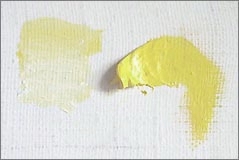
Origin, History and Characteristics
(massicott, giallolino)
If natural ultramarine blue could be considered the king of Vermeer's palette, lead-tin yellow would justly be called its queen. What is now commonly called lead-tin yellow has had several different names in the past. Italian manuscripts have described a color, "gialllolino," which is identical to lead-tin yellow. In the northern parts of England, the term "massicott" was used to describe the same pigment.There are two main types of lead-tin yellow: Lead-tin yellow type I (Pb2SnO4), which has a warmer, lemon-yellow hue, and Lead-tin yellow type II (Pb(Sn,Si)O3), which is a paler, more muted yellow. Historically, while it was not as expensive as some other pigments (like ultramarine blue made from lapis lazuli), it wasn't as inexpensive as earth-based pigments. The cost would also depend on the quality and fineness of the pigment.
As its name suggests, lead-tin yellow is made from a combination of lead and tin oxides. Depending on the specific ratio of these elements, the color can range from a bright lemon yellow to a deeper gold. The pigment was typically made by heating a mixture of lead oxide (litharge) and tin oxide in the presence of air. The exact temperature and conditions could influence the color and properties of the resulting pigment. Like many historical pigments containing lead, lead-tin yellow is toxic if ingested or inhaled, which poses health risks for those who might handle it without proper precautions.Lead white was banned in Europe due to its severe health and environmental risks. Chronic exposure in adults can result in issues like high blood pressure and fertility problems. Furthermore, lead can pollute soil and water systems, affecting the broader environment. As awareness of these dangers grew, European countries regulated and eventually banned its use in commercial paints, advocating for safer alternatives like titanium white.
Lead-tin yellow is opaque and has excellent covering power. It behaves much like lead white, which has a unique "ropey" consistency, making it ideal for thick impasto application, particularly recommended for the most light-catching passages of a painting. In addition, it has good lightfastness, which means it doesn't fade easily when exposed to light. When mixed aptly, lead-tin yellow exhibits a rich, buttery consistency. These characteristics allow artists to effectively layer the paint, achieving almost sculptural effects, especially when manipulated with stiffer tools like stiff hog hair brushes and palette knives. These raised areas of paint catch and refract light, casting minute shadows and imbuing the paint with depth, tactile allure, and visual prominence.
The manipulative characteristic of lead-tin yellow made it a valuable pigment for artists and was employed by both painters of the highest renown and the lowest artisan/artists. Rembrandt, in particular, exploited the thick texture of lead-tin yellow and frequently modeled it with the wooden handle of his brush to recreate the glimmer of gold and gilt trim.
Lead-tin yellow has a distinct lemon hue (fig. 1) and is very light in tone, much nearer white than another common yellow pigment, ochre. It was commonly used in drapery, light parts of the sky, foliage with green and earth pigments.It is worth noting that lead-tin yellow, being lead-based, can react with certain other pigments, especially if they are sulfur-based, leading to discoloration. Artists had to be careful when layering or mixing it with pigments like vermilion or ultramarine blue. It has a moderate tinting strength and when mixed with other colors, it can influence the resulting hue without overpowering it. It is sometimes is also found in particularly bright flesh tones although its slighly greenish tinge makes it is hard manage.
LOOKING OVER VERMEER'S SHOULDER
The complete book about Johannes Vermeer's and 17th-century fine-painting techniques and materials
by Jonathan Janson | 2020
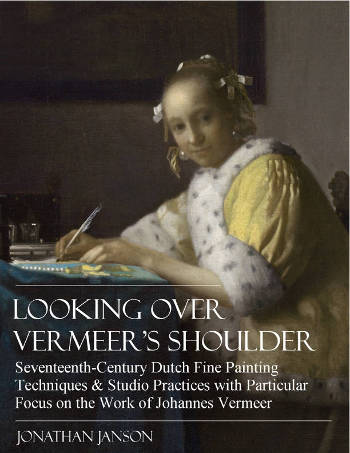
Enhanced by the author's dual expertise as both a seasoned painter and a renowned authority on Vermeer, Looking Over Vermeer's Shoulder offers an in-depth exploration of the artistic techniques and practices that elevated Vermeer to legendary status in the art world. The book meticulously delves into every aspect of 17th-century painting, from the initial canvas preparation to the details of underdrawing, underpainting, finishing touches, and glazing, as well as nuances in palette, brushwork, pigments, and compositional strategy. All of these facets are articulated in an accessible and lucid manner.
Furthermore, the book examines Vermeer's unique approach to various artistic elements and studio practices. These include his innovative use of the camera obscura, the intricacies of his studio setup, and his representation of his favorite motifs subjects, such as wall maps, floor tiles, and "pictures within pictures."
By observing closely the studio practices of Vermeer and his preeminent contemporaries, the reader will acquire a concrete understanding of 17th-century painting methods and materials and gain a fresh view of Vermeer's 35 masterworks, which reveal a seamless unity of craft and poetry.
While the book is not structured as a step-by-step instructional guide, it serves as an invaluable resource for realist painters seeking to enhance their own craft. The technical insights offered are highly adaptable, offering a wealth of knowledge that can be applied to a broad range of figurative painting styles.
LOOKING OVER VERMEER'S SHOULDER
author: Jonathan Janson
date: 2020 (second edition)
pages: 294
illustrations: 200-plus illustrations and diagrams
formats: PDF
$29.95
CONTENTS
- Vermeer's Training, Technical Background & Ambitions
- An Overview of Vermeer’s Technical & Stylistic Evolution
- Fame, Originality & Subject Matte
- Reality or Illusion: Did Vermeer’s Interiors ever Exist?
- Color
- Composition
- Mimesi & Illusionism
- Perspective
- Camera Obscura Vision
- Light & Modeling
- Studio
- Four Essential Motifs in Vermeer’s Oeuvre
- Drapery
- Painting Flesh
- Canvas
- Grounding
- “Inventing,” or Underdrawing
- “Dead-Coloring,” or Underpainting
- “Working-up,” or Finishing
- Glazing
- Mediums, Binders & Varnishes
- Paint Application & Consistency
- Pigments, Paints & Palettes
- Brushes & Brushwork
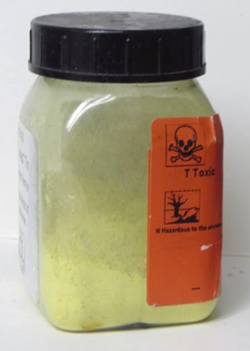 fig. 1
fig. 1 A plastic jar containing powdered lead-tin yellow pigment
Lead-Tin Yellow in Vermeer's Painting
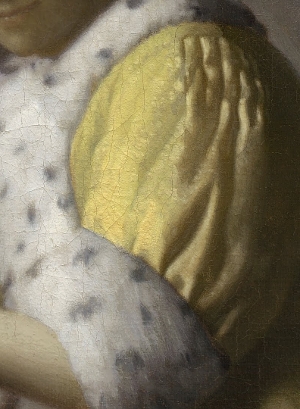 fig. 2 A Lady Writing (detail)
fig. 2 A Lady Writing (detail) Johannes Vermeer
c. 1662–1667
Oil on canvas, 45 x 39.9 cm.
National Gallery of Art, Washington D.C.
Vermeer employed lead-tin yellow in diverse ways. At times, it decisively influenced the painting's harmony, while on other occasions, he used it sparingly, subtly enhancing the overall balance and crafting specific lighting effects. For example, in Woman in Blue Reading a Letter, he masterfully manipulates light from the upper left, creating nuanced highlights and shadows. Notably, the brass nails on the blue chair have highlights facing this light source. Though the effect appears straightforward, an infrared reflectogram shows Vermeer's meticulous technique. He initially painted each nail with a light color, likely lead-tin yellow, then added shadows using a dark glaze, heavier on the nail's right. A dot of lead-tin yellow over the glaze added the finishing touch. Similar highlights can be observed in the hair band and the map.Arthur K. Wheelock Jr., "Vermeer's Craft and Artistry," in The Cambridge Companion to Vermeer (Cambridge Companions to the History of Art), ed. Wayne Franits (Cambridge: Cambridge University, 2001), 148.
"Lead-tin yellow is the principal pigment used by Vermeer for his characteristic yellow draperies, including the fur trimmed jackets. Two different preparations of lead-tin yellow were used in the yellow jacket of A Lady Writing (fig. 2). Vermeer seems to have first modeled the strong lights with a coarser variety of lead-tin yellow and the then refined the modeling. He textured the underpaint by using granular pigments and strongly marked brush handling. These textured passages of underpaint were used in the final image, where they draw the viewer's attention. The lightest passages are literally the most eye-catching parts of the painting."E. Melanie Gifford, "Painting Light: Recent Observations on Vermeer's Technique," in Vermeer Studies, edited by Ivan Gaskell and Michiel Jonker (Washington D.C.: National Gallery of Art; New Haven and London: Yale University Press, 1998), 1998. However, it has been recently pointed out that the granular surface in some areas of Vermeer’s paintings that has sometimes been interpreted as a deliberate painting technique designed to refract light may not have been part of original intention of the artist, but due to an alteration of the artist’s painting materials.Reissner, E. "Texture, Transparency and Opacity in the Writing of Art History: Approaches to Materiality in the Study of Netherlandish Painting of the Seventeenth Century." Zeitschrift für Kunsttechnologie und Konservierung 26, no. 2 (2012): 448–61. Some of the yellow garments have show traces of a yellow lake—which at the time was well know to be prone to fading— in the lead-tin-yellow pigment. It is possible that "he accepted some alteration or he may have believed that this mixture was proof against fading (as suggested in the manuscript by Sir Theodore Turquet de Mayerne, an art lover who compiled artists’ advice on painting). A modern viewer, however, should be aware that Vermeer’s distinctive tan-yellow jackets would originally have been brighter."E. Melanie Gifford and Lisha Deming Glinsman, "Collective Style and Personal Manner: Materials and Techniques of High-Life Genre Painting," in Vermeer and the Masters of Genre Painting: Inspiration and Rivalry, eds. Adriaan Waiboer and Eddy Schavemaker (London and New Haven: Yale University Press, 2017), 69.
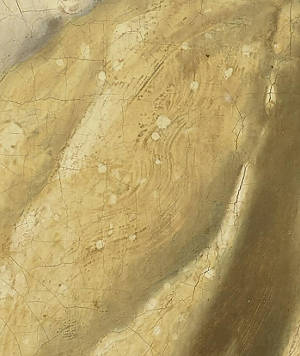 fig. 3 Mistress and Maid (detail)
fig. 3 Mistress and Maid (detail) Johannes Vermeer
c. 1666–1667
Oil on canvas, 90.2 x 78.7 cm.
Frick Collection, New York
Vermeer mixed lead-tin yellow with various shades of blue to obtain subtle greens. The green trompe-l'œil curtain in the Girl Reading a Letter at an Open Window was made with lead-tin yellow and azurite. The same combination occurs in the green shutter in the Little Street. A particularly striking example of the use of lead-tin yellow can be seen in the illuminated tower of the New Church in the View of Delft. Its vivid appearance is enhanced by its distinctively textured application, capturing light more effectively than the smoothly rendered tones of the sky around it. The undulating impasto brushstrokes on the sleeve of Mistress and Maid (fig. 3) demonstrate Vermeer's use of the pigment to convey a tangible presence that transcends mere visual representation.
Vermeer's mastery of color can be seen in his use of lead-tin yellow, which is very difficult to harmonize with flesh tones.
One particularly intriguing use of lead-tin yellow occurs in the greenish highlights, which contained lead-tin yellow, of the far sleeve of the Woman Holding a Balance (fig. 4). There seems to be no logical explanation for these greenish highlights in the lighting condition represented in the painting, but it must have had some significance for the artist since he repeated precisely this technique in the later Girl with a Red Hat (fig. 5). Arthur K. Wheelock Jr., who has extensively analyzed Vermeer's painting technique, gives the following explanation: "By accenting the highlight with bright yellow strokes rather than with white or light blue ones, he imbued the cool blue robe with a certain warmth without reducing its level of color saturation."Arthur K. Wheelock Jr., Vermeer and the Art of Painting (New York and New Haven: Yale University Press, 1995), 122. In any case, the jacket of the Girl with a Flute was created using a similar technique, but the colors appear somewhat less fresh and the strokes less fluid, although this could be due to the non-optimal state of the conservation of the paint surface.
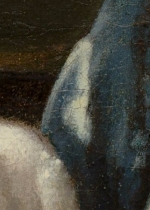 fig. 4 Woman Holding a Balance (detail)
fig. 4 Woman Holding a Balance (detail) Johannes Vermeer
c. 1662–1665
Oil on canvas, 42.5 x 38 cm.
National Gallery of Art, Washington D.C.
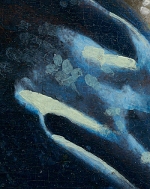 fig. 5 Girl with a Red Hat (detail)
fig. 5 Girl with a Red Hat (detail) Johannes Vermeer
c. 1665–1667
Oil on panel, 23.2 x 18.1 cm.
National Gallery of Art, Washington, D.C.
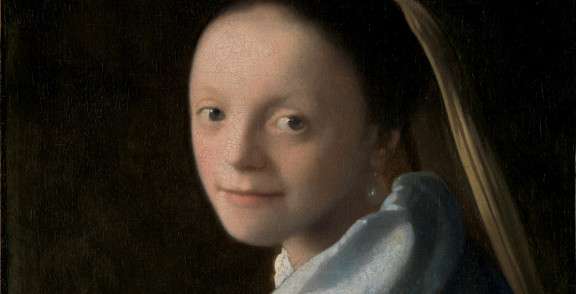
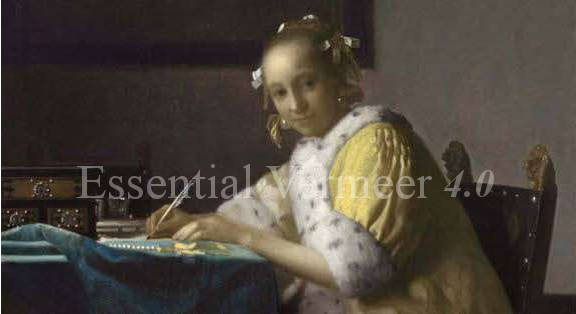



 or anything else that isn't working as it should be, I'd love to hear it! Please write me at:
or anything else that isn't working as it should be, I'd love to hear it! Please write me at: